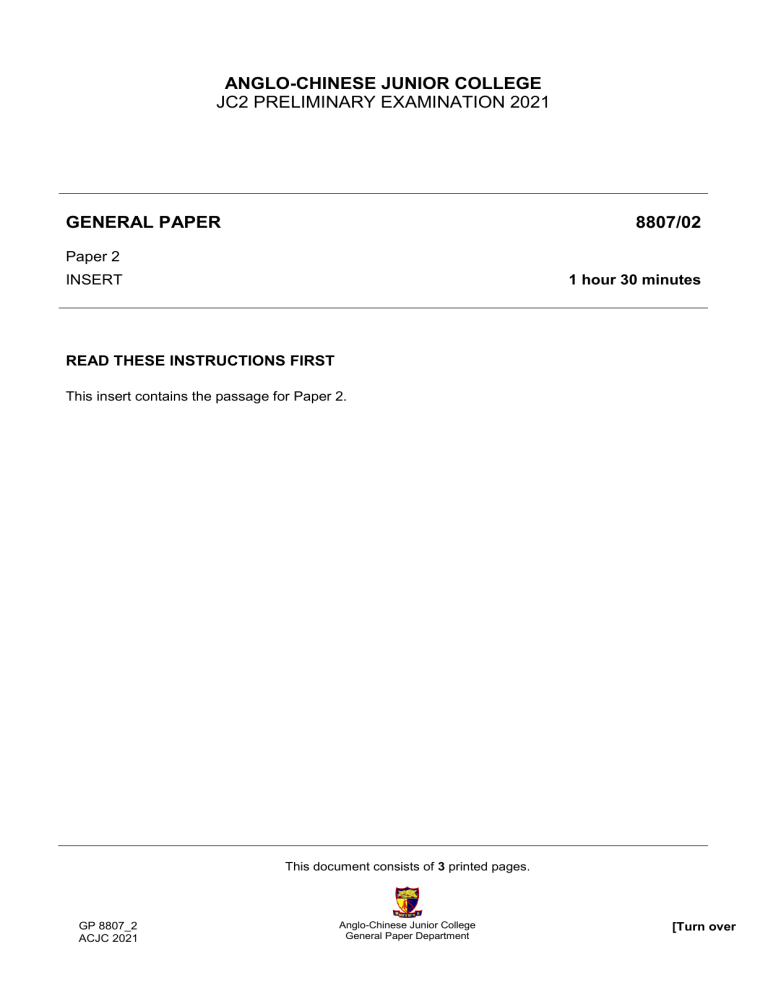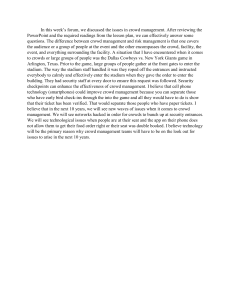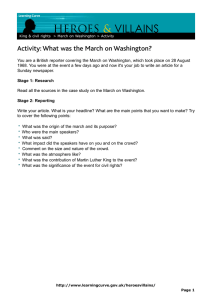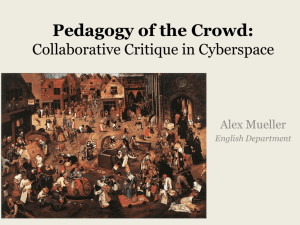
ANGLO-CHINESE JUNIOR COLLEGE JC2 PRELIMINARY EXAMINATION 2021 GENERAL PAPER 8807/02 Paper 2 INSERT 1 hour 30 minutes READ THESE INSTRUCTIONS FIRST This insert contains the passage for Paper 2. This document consists of 3 printed pages. GP 8807_2 ACJC 2021 Anglo-Chinese Junior College General Paper Department [Turn over 2 Dan Hancox discusses the power of crowds. 1 2 As lockdown loomed in March, I became obsessed with a football anthem for a team 400 miles away. I found a glorious video of 26,000 fans singing it after a long-hoped-for Scottish Cup win in 2016. I was entranced. I watched it again and again. The sight and sound of this collective joy was transcendent: tens of thousands of green-and-white scarves held aloft, everyone belting out the song at the top of their lungs. When the crowd hits the chorus, the volume levels on the shaky smartphone video blow their limit, exploding into a delirious roar of noise. If you get enough people singing together, with enough volume, it always sounds good. Our individual failings are submerged; we become greater than the sum of our meagre parts. While many of us were missing crowds, the realities of Covid-19 meant they had taken on a completely new meaning. Gathering with others was suddenly, paradoxically antisocial: it suggested you were careless about viral transmission of a deadly disease, more interested in your own shortterm social needs than the lives of strangers. The very sight of a crowd suddenly seemed alarming. We shook our heads at rumours of parties and shared pictures of festivals or gigs as if they were clips from horror films – gatherings of any kind became fatal. As lockdown begins to ease, people are again gathering to socialise in parks and on beaches, and to rail against injustice in Black Lives Matter and Extinction Rebellion protests, but crowds as we used to know them will not be coming back for many months to come. 5 10 15 3 Even before the Covid-19 lockdown, crowds have been under threat. Crowds have always had a bad rap: there is no gentle mob, no friendly pack. The same disinhibition that allows for moments of great joy can also enable grotesque crimes. The people who gathered to watch lynchings in the US or 20 recent attacks on Muslims by groups of Hindu nationalists in India were not just bystanders but participants. Their presence and acquiescence helped make the violence possible. And just as the people at the back of the crowd empower those at the front, the reverse can be true. The hooligan firm leader who throws the first cafe chair across a moonlit plaza on a balmy European awayday makes it easier for more timid members of the crowd to cross their own ‘cooperation threshold’ and 25 join in. Even celebratory or worshipful crowds can go wrong, and when they do, they generate an unmatched horror. Few things strike fear like the idea of mass panic, few words as chilling as ‘caught up in a stampede’ or ‘trampled to death’. For some people, even a peaceful and orderly crowd can be scary, triggering intense anxiety or post-traumatic stress disorder. 4 The power of crowds has long fixated religious and secular leaders alike, who have sought to harness 30 communal energy for their own glorification or to tame mass gatherings when they start to take on a momentum of their own. The medieval Christian church waged a long battle to eradicate unruly, ecstatic or immoderate dancing from the congregation. In later centuries, festivals, feast days and ecstatic rituals of countless kinds were outlawed for their tendency to result in drunken, pagan or otherwise ungodly behaviour. As industrialising cities exploded in size, the formal study of crowd 35 psychology and herd behaviour emerged. Thinkers such as Gustave Le Bon helped promote the idea that a crowd is always on the verge of becoming a mob. Stirred up by agitators, crowds could quickly turn to violence, sweeping up even good, upstanding citizens in their collective madness. ‘By the mere fact that he forms part of an organised crowd,’ Le Bon wrote, ‘a man descends several rungs in the ladder of civilisation.’ 40 5 Informed by tragedies, uprisings and protests alike, for a long time, crowds were seen as inherently dangerous and lobotomising. But during the past couple of decades, a new understanding of the complexity of crowd behaviour has become increasingly influential. For most of us, a crowd can be an alluring thing because the desire to be among the throng seems to be innate. Gathering together for ritualistic celebrations – dancing, chanting, festivalling, costuming, singing, marching – goes back almost as far as we have any record of human behaviour. Dancing and music-making was a social glue that helped stone-age families join together in groups larger than the family unit, to hunt and protect themselves from predators. Rituals of collective joy are as intrinsic to human development as speech. 45 3 6 7 8 9 10 Detailed analytical research has produced ever more sophisticated insights into crowd behaviour, many of which disprove long-standing assumptions. Crowds have an amazing ability to police themselves, self-regulate and actually display a lot of pro-social behaviour, supporting others in their group. In the 2017 Manchester Arena terrorist attack, CCTV footage showed members of the public performing first aid on the wounded before emergency services arrived and Mancunians rushed to provide food, shelter, transport and emotional support for the victims. Strange things happen to our brains when we are in a crowd we have chosen to be part of. We do not just feel happier and more confident, we also have a higher threshold of disgust. This is why festival-goers will happily share drinks with strangers or Hajj pilgrims will share the sometimes bloody razors used to shave their heads. In a crowd, we feel safer from harm. 50 In place of the open crowd, nowadays we have come to understand a congregation of people primarily as a money-making opportunity. There is no greater evidence of the attenuated, monetised nature of the 21st century crowd than the rise of the events industry. Events are usually sponsored, probably with an admission fee, probably with a range of media partners, good for city-branding, good for tourism, orderly, pre-agreed, surveilled and dispersed at the agreed time. They have become an integral part of the contemporary city and the reimagining of its citizens as income-generating instruments. 60 Crowd behaviour in the 21st century has been conditioned by the new devices at our fingertips as much as the changing ground beneath our feet or the laws that govern its movement. New types of crowds are able to act in concert even before they meet; a ‘social tsunami’ coming from the next wave of mobile telecoms. The 2009 Iran Green Revolution, the 2011 Arab Spring, the Occupy movement – all of these ‘movements of the squares’ saw physical public space unexpectedly replenished with fresh, angry crowds that had established many of their initial networks and political education via the internet. ‘Online inspiration, offline perspiration’, as one slogan of the time put it. The 21st century domestication of the crowd through policing, planning and management does not in itself snuff out its power. The experience of being part of a crowd can still change us in all manner of unexpected ways. If one thing should be retained from the debunking of the myth of the crowd as a single beast with one brain and a thousand limbs, it is precisely that the diversity of the individuals within the crowd is what makes it so vital. Far from behaving as one, everyone has different cooperation thresholds for participation and there are some who by their nature will always be the first in the pool. For better or worse, crowds empower more shy or conservative people to do what they might not have done otherwise: to pronounce their political beliefs, to proclaim their sexual orientation in public, to sing about their heartfelt feelings for football teams, to dance to Abba in the concourse of a major intercity railway station. If we now have a better grasp of the complexity of crowd dynamics, the core truth about them is relatively simple: they have the potential to magnify both the good and bad in us. The loss of self in a crowd can lead to unthinkable violence, just as it can lead to ecstatic transcendence. Being a crowd member is not a muscle that will atrophy through lack of use – our knack for it and need for it, has a much longer history than the months we will be required to keep our physical distance. The desire to be part of the crowd is a part of who we are and it will not be dispersed so easily. © Extract from THE POWER OF CROWDS by Dan Hancox, published by The Guardian 55 65 70 75 80 85




